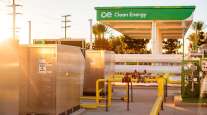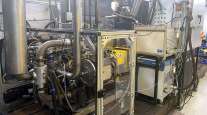Senior Reporter
Renewable Natural Gas Gains Momentum as Trucking Fuel
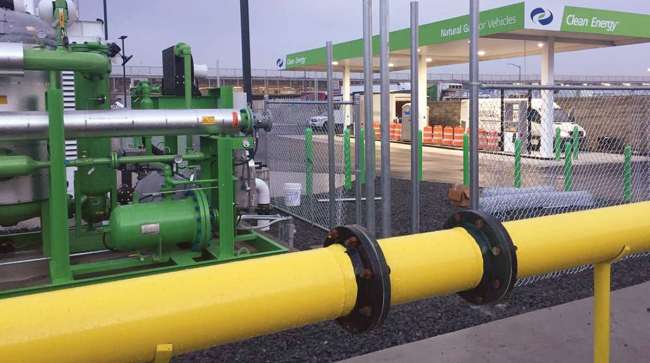
[Stay on top of transportation news: Get TTNews in your inbox.]
Progressively tougher clean air mandates and the increasing corporate focus on environmental sustainability could signal a larger role for natural gas — especially renewable natural gas — as a trucking fuel, experts said.
Although much of the industry’s conversation about alternative fuels has turned to electric-powered trucks in recent years, advocates for renewable natural gas, or RNG, point out that the fuel is capable of reaching net negative emissions of greenhouse gases by removing more carbon from the air than it creates.
RNG projects, unlike fossil fuel natural gas production, capture methane from existing food waste, animal manure, wastewater sludge and garbage, then repurpose it as a clean, green energy source, according to the Coalition for Renewable Natural Gas.
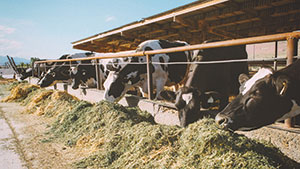
Renewable natural gas is produced by extracting methane from organic waste sources such as animal manure. (Getty Images)
“[Putting] RNG into [compressed natural gas] vehicles will be the best balance of environmental performance and cost in many heavy-duty applications for the foreseeable future,” said Sam Wade, the coalition’s director of state regulatory affairs.
The coalition noted 53% of all on-road fuel used in natural gas vehicles, or 345 million gasoline gallon equivalents, was RNG in 2020. Usage of RNG as a transportation fuel increased 25% compared with 2019 and is up 267% over the past five years.
More broadly, fossil fuel natural gas is abundant in the United States.
The U.S. Energy Information Administration reported natural gas was the most produced form of U.S. energy in 2019 at 34.9 quadrillion British thermal units. Crude oil was next at 25.4 quadrillion BTUs.
EIA cited more efficient drilling and production techniques in shale and tight geologic formations. Rising production has contributed to a decline in natural gas prices, which in turn has led to greater use of natural gas in the electric power and industrial sectors, the agency said.
Cummins Westport Inc. is the key engine supplier in the transportation space. In March the company launched the ISX12N+Endurant HD N, a fully integrated natural gas powertrain with a 12-speed automated transmission for heavy-duty customers.
“Our natural gas spark-ignited combustion engines provide emissions lower than current EPA standards, 90% below on particulate matter and nitrogen oxides and 16% below on GHGs. They can achieve sub-zero emissions when using RNG,” Cummins Vice Chairman Tony Satterthwaite recently told the U.S. Senate Committee on Energy and Natural Resources.
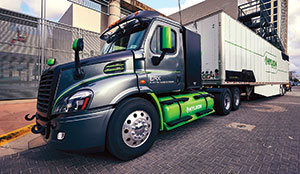
Hyliion’s electric powertrain for heavy-duty trucks uses natural gas to power an onboard generator that charges the batteries to increase the vehicle’s range. (Hyliion)
Another company, Hyliion, intends to enable green longhaul trucking by using RNG or CNG to fuel an onboard generator that charges batteries powering electric motors on the axles.
“The power in our system comes from the electric, not the natural gas,” Hyliion CEO and co-founder Thomas Healy said. “Natural gas fuel isn’t bad. The problem is more the vehicle architecture and the vehicle’s performance.”
Hyliion’s Hypertruck ERX powertrain is in fleet demonstration vehicles, with volume production scheduled in 2022, according to the Austin, Texas-based company, founded in 2015.
It remains to be seen if and when these factors will lift any form of natural gas fuel beyond its modest presence in trucking today.
“Volumes for natural gas-powered trucks and buses in the U.S. have remained in a narrow band between 5,200 and 5,800 units per year since 2016, with market share bouncing between 2% and 3%,” said ACT Research President Kenny Vieth.
READ MORE: California Drayage Fleets Face Potential Zero-Emission Mandate
“Given the higher price for natural-gas powered vehicles,” Vieth said, “different maintenance regimens, and what appear to be challenging aftermarket valuations, it is hard to see much movement [in share], at least in the truck market, before the California Air Resources Board rules take effect.”
CARB has set progressive mandates for sales of zero-emission trucks beginning in 2024, and Vieth expects a sharp increase in the price of diesel power beginning in California that year. At that point, “the total cost of ownership case for natural gas power should improve materially relative to diesel,” he said.
By 2035, CARB has said zero-emission truck/chassis sales in California would need to reach 55% of Classes 2b-3 truck sales, 75% of Classes 4-8 straight truck sales and 40% of truck tractor sales.
CARB’s new rules also have bolstered efforts to develop battery-electric vehicles. Wade said the Coalition for Renewable Natural Gas believes battery-electric and hydrogen fuel cell vehicles will be important long-run markets that can also be supplied by RNG.
Vieth said there is a healthy market for RNG fuel that extends beyond “free fuel” for refuse trucks from landfills.
“It may be that the value of RNG is higher in the open market than the fuel cost saving in refuse,” he said.
At the same time, California has promoted RNG in natural gas vehicles for a long time and helped the industry reach commercial scale, Wade said.
There are 157 RNG production facilities currently operating, while another 76 are under construction and 79 are in advance stages of planning, according to the RNG coalition.
Wade added that CARB, through its Carl Moyer Memorial Air Quality Standards Attainment Program and others, still funds natural-gas vehicle grants but is phasing those out to focus on tradable emissions credit programs.
“And these programs do make it cost competitive to run a CNG fleet with RNG today,” Wade said. “Inclusive of support from the federal renewable fuel standard and the California low carbon fuel standard, RNG in CNG fleets can now be priced at parity with diesel.”
In California, 77% of all on-road fuel used in natural gas vehicles in 2019 was RNG, the coalition reported.
Major fleet operators investing in natural gas vehicles include Amazon.com Inc., which announced in February that it ordered more than 700 CNG-powered Classes 6-8 trucks — reportedly for runs from warehouses to distribution centers.
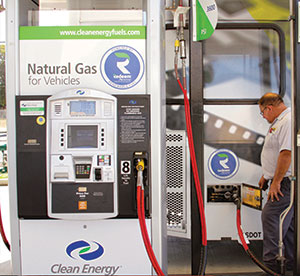
Natural gas supplier Clean Energy plans to offer its renewable product, Redeem, across its entire fueling infrastructure by 2025. (Clean Energy)
In April, Clean Energy Fuels Corp. signed an agreement with Amazon to provide low- and negative-carbon RNG at 27 existing Clean Energy fueling stations. The agreement also will include another 19 non-exclusive new or upgraded Clean Energy-owned stations that Clean Energy expects to be constructed by the end of the year. The new and existing stations will provide RNG in 15 states.
A financial analyst noted that Amazon’s investment focuses on carbon intensity, or CI, a measure of all greenhouse gas emissions associated with the production, distribution and consumption of a fuel.
“Amazon is making a clear distinction that carbon intensity matters,” wrote Credit Suisse’s Manav Gupta, who added that landfill RNG, at 50-70 CI, is not the same as dairy farm RNG, with -150 to -350 CI.
https://t.co/HEWK3RHAT3 @Amazon $CLNE — Clean Energy (@CE_NatGas) April 19, 2021
Parcel giant UPS Inc. is another major company operating natural gas vehicles as part of its alternative fuels fleet.
“Electrification is in the near future, and we have started to prepare for it,” Michael McDonald, UPS’ senior director of maintenance and engineering for sustainability and government affairs, told TT. “Until then, we thought it better to utilize today’s available technology to reduce the UPS carbon footprint. CNG is an alternative fuel that is abundant.”
With RNG, the tailpipe emissions are very near zero, McDonald added. “Even by CARB standards in California, the emissions would keep our CNG fleet compliant until 2027. Our fleet consists of both Classes 6-8 vehicles that are CNG and RNG compatible.”
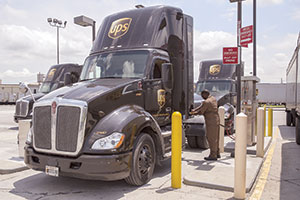
UPS is operating natural gas-powered trucks as part of the company’s efforts to reduce its carbon footprint. (UPS Inc.)
In October 2019, UPS announced it would spend $450 million to add 6,000 vehicles powered by CNG as well as supporting infrastructure beginning in 2020. It was the largest multiyear commitment UPS has made to date for alternative fuel vehicles.
UPS ranks No. 1 on the Transport Topics Top 100 list of the largest for-hire carriers in North America.
Another fleet operating a large number of natural gas-fueled trucks is earning new business because of that investment.
“Companies want to know how we can help them meet their sustainability goals,” said Don Hayden, president of M&M Cartage, a trucking and logistics provider based in Louisville, Ky.
The company’s overall fleet of 275 vehicles includes 100 Class 8s running on RNG. He also built a public natural gas fueling station and a maintenance facility designed to service those trucks.
Having alternative-fueled trucks “has definitely opened doors,” Hayden said. “It’s real. It’s there.”
M&M measures its carbon footprint and reports it to the CDP, formerly known as the Carbon Disclosure Project, in London, he said. “We are focused on how to improve our footprint per 100,000 miles. Those are the kinds of goals we’ve set.”
Hayden is planning extensive upgrades to his oldest CNG trucks from 2014 and 2015, including replacing transmissions, AC systems and driver comfort features such as seats. “It’s a $50,000 overhaul, not a $25,000 overhaul per truck.”
His plan all along was to operate the CNG trucks “cradle to grave.”
But utilizing diesel trucks at the same time ensures redundancy if there is a problem with temporary supply shutdowns by the local natural gas utility, which happened one recent weekend, Hayden added. “I never visualized going 100% natural gas.”
Want more news? Listen to today's daily briefing below or go here for more info:



